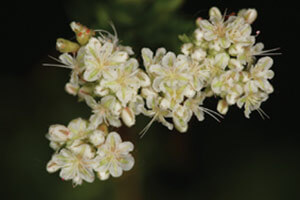
California buckwheat, Eastern Mojave buckwheat, Wild buckwheat, Flat-top, Flat-top wild buckwheat
Scientific name: Eriogonum fasciculatum. (Family Polygonaceae)
To this writer, trained as an entomologist, the genus Eriogonum appears to be a large and complex genus. In the Flora of North America[9] (1991), J.L. Reveal lists 224 American species, many having several varieties. The 2012 Jepson Manual, Vascular Plants of California[3] by my count, lists 117 species, many of which have several varieties. The USDA Plants Website in 2016[11], again by my count, lists 223 species and numerous varieties and also 3 hybrids. Some of these species and perhaps also the hybrids probably produce nectar, which when made into honey almost certainly cannot be distinguished from that of E. fasciculatum with which it may be mixed. From this group, I have chosen to provide information about the species Eriogonum fasciculatum because it seemed to be the most prevalently mentioned species in the beekeeping literature.
Synonyms: Eriogonum rosmarinifolium var. foliolosum, Eriogonum polifolium.[11]
Origin: Native to North America (See map).
Plant description: As my introduction to this species, the Flora of North America[ 9] states: “Eriogonum fasciculatum is a complex polyploidy series of varieties that are generally distinct but are often difficult to distinguish morphologically”. In that reference four varieties of the species are distinguished. According to the reference used here[3], in general form, the species varies between a perennial mat1 to a shrub.
Their heights occasionally range from as low as 10 cm (~3.9 in) to more commonly 20-150 cm (~ 7.9- 59.1 in). Their diameters commonly range between 20-250 cm (7.9-98.4 in ) but occasionally can be as large as 300 cm (~118 in).
The stems generally varies in length between 3-25 cm (~1.2-9.8in) but occasionally can be as long as 30 cm (~ 11.8 in) and can be tomentose2, hairy or glabrous.3
The leaves are not arranged basally but are placed along the main stem. They generally range in length 0.6-1.5 cm (~0.24-0.59 in) to occasionally 1.8 cm (0.71 in) and in width range 0.05-0.4 cm (~.02-0.16 in) to occasionally 0.6 cm (~0.24 in). They are generally long and narrow with parallel sides (linear) and can be tomentose, just generally hairy or even smooth and without hairs. The leaf margins are generally rolled under.4
The inflorescence is 0.2-20 cm (~0.08-7.9in) long and 0.2-15 cm (~0.08-5.91 in) wide. The branches of the inflorescence can be tomentose, hairy or glabrous.
There are no peduncles.5 There is a group involucres6 commonly consisting of 3-8, but occasionally only one leaflike structure beneath the florets. They generally range from 2-4 mm (~0.08-0.16 in) in length and 1.5-3 mm (~0.06-0.12 in) in width, and can be covered with short matted, soft wooly hairs (tomentose), or be hairy or glabrous.
The flowers are 2.5-3mm (~0.1-0.12 in) and can be glabrous or hairy and the petals can be white or more or less pink and can be elliptical to egg shaped, then with their attachment at the narrow end. The fruits are glabrous (smooth) and 1.8-2.5 mm (~0.07-0.1 in).[3]
As explained above, while the intention here is to describe primarily Eriogonum fasciculatum, the genus has numerous species in California which range in flower color from white through pink and yellow[3]. Presumably some of these, perhaps many, also produce nectar which could not be distinguished at honey harvest time.
It seems likely that early writers would not have considered the genus Eriogonum to be composed of as many species as are described for it today and therefore that early honey production reports ascribed to Eriogonum fasciculatum might have represented what are now considered several species within the genus.
Distribution: Coleman[2] provides the information that the species was abundant on all the mesas and mountain slopes of southern California, particularly in San Diego Co. Munz[6] indicates that the species is found on the dry slopes and canyons near the immediate coast, the Coastal Sage Scrub; and from Santa Barbara to northern Lake California. See also the map provided by the USDA Plants Website.[11]
Blooming period: Richter[10] describes the plant blooming April to November, but also states that it “blooms two months earlier on the valley side of the Coastal Range mountains” than on the coastal side. In the California area described above, Munz[6] states that the species blooms May to October. Coleman[2] provides a blooming period for California as April to November. John Lovell[5] claimed that the honey flow in southern California occurs in July and August and usually later than that of the sages, but when it comes at the same time as that of the sages, the sage honey flow is colored amber rather than the white of pure sage honey.
Importance as a honey plant: Richter[10] describes the plant as being common throughout southern California calling it “The principal honey-producing plant in many southern California apiaries.”
George Coleman[2] ranked it third as a honey producer in its range, coming after the first and second honey producers (white and black sage). He goes on to say there are numerous (he used dozen) other species of …


